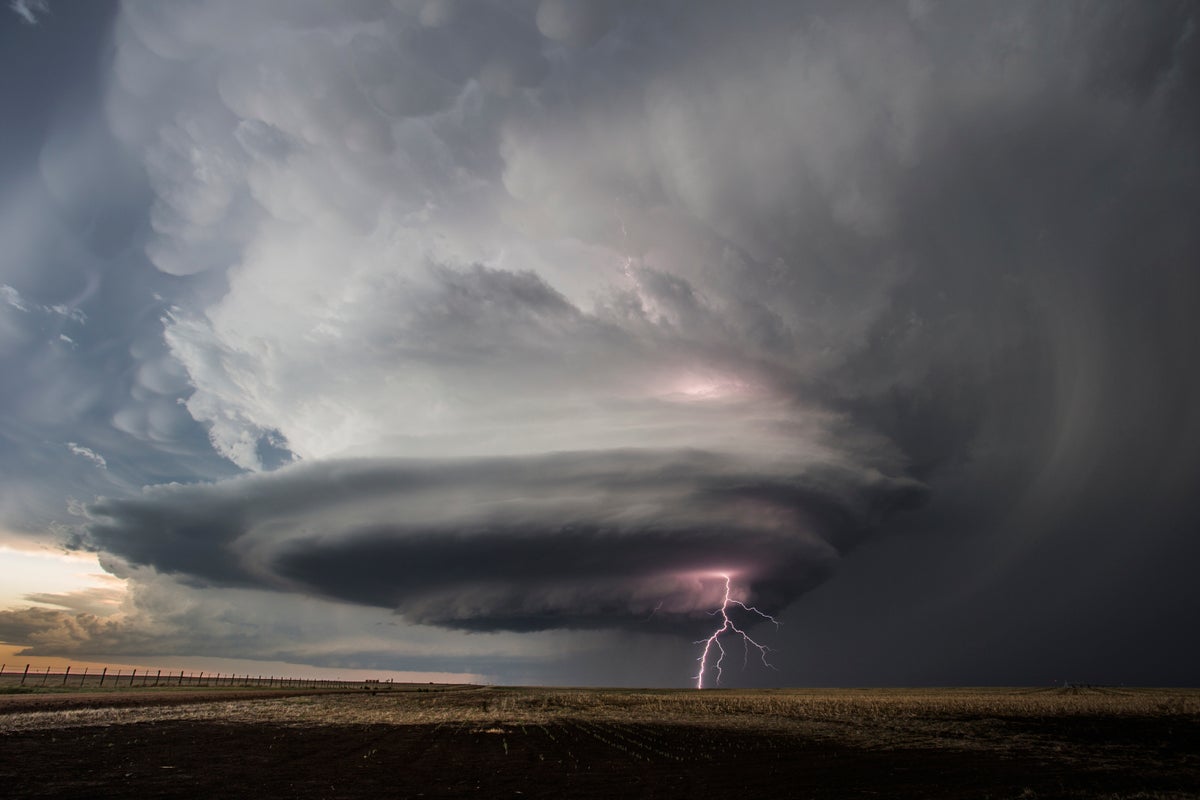
The United States is likely to experience more supercell storms that generate tornadoes and hail as the world heats up, according to a new study.
Supercells are a type of large thunderstorm found most commonly in central parts of the US, according to the National Oceanic and Atmospheric Administration.
A 6.6 per cent increase in supercells is predicted nationwide by the study, published in the Bulletin of the American Meteorological Society.
A 25.8 per cent increase is also projected in the scale and duration of the strongest supercells, based on a “moderate” level of emissions rise in the coming decades.
In parts of the south, there will be an even greater increase in supercells, according to the study, which includes the area of Rolling Fork, Mississippi where a massive tornado killed dozens of people and oblierated most of the buildings last Friday.
The study used computer simulations to predict what will happen in the coming decades, based on how successful countries are in cutting planet-heating carbon emissions.
But it seems like a stormier future is already here, according to the study’s authors.
“The data that I’ve seen has persuaded me that we are in this experiment and living it right now,” said lead author Walker Ashley, a professor of meteorology and disaster geography at Northern Illinois University.
“What we’re seeing in the longer term is actually occurring right now.”
The US has experienced an increasing number of tornadoes in the past decade. The latest assessment from the world’s leading scientific body, the Intergovernmental Panel of Climate Change, found that the intensity and frequency of storms is increasing as the planet warms.
While the study has predicted a general increase in supercell counts, its findings also largely point to significant shifts in where and when such storms hit – generally more east of Interstate 35 which runs through east central Texas, Oklahoma and Kansas, and fewer to the west.
If global heating was more moderate – less than the world is headed for based on current emissions – parts of eastern Mississippi and eastern Oklahoma are projected to get three more supercells every two years and eastern Texas, Arkansas, Louisiana, Alabama, western Tennessee and eastern Georgia would get one more supercell every other year.
The lethal storms will edge eastward to strike more frequently in more populous areas, like the southern states of Alabama, Mississippi and Tennessee.
Past studies have been unable to forecast supercells and tornadoes in future climate simulations because they, especially tornadoes, are small-scale events that global computer models can’t see.
Mr Ashley and co-author Victor Gensini, another meteorology professor at Northern Illinois University and a longtime tornado expert, used smaller regional computer models and compensated for their reduced computing power by spending two years running simulations and crunching data.
They pointed out that the supercell storm that devastated Rolling Fork was a single event that can’t be connected to the climate crisis. However, it does fit that projected and more dangerous pattern, including more nighttime strikes in a southern region with more people, poverty and vulnerable housing than where storms hit last century.
Supercells are nature’s ultimate storms that produce significant tornadoes and hail. They have a rotating powerful updraft of wind and can last for hours.
Tall, anvil-shaped and sky-filling, supercells spawned the 2013 Moore, Oklahoma tornado that killed 51 people, the 2011 Joplin, Missouri tornado outbreak had killed 161 people and a supercell outbreak in 2011 had killed more than 320 people in Alabama, Mississippi and Tennessee.
The study authors attributed the increase in supercell activity to the climate crisis, specifically hotter and drier conditions in the southwest and a hotter, more unstable Gulf of Mexico.
The resulting cap on where storms can brew in springtime means supercells form later and further eastward than usual, leading to a higher risk of storms in densely populated areas in the eastern US.
Populations that come under more risk of supercell storms are also poorer and more frequently live in mobile or manufactured homes, which are more dangerous places to be in when tornadoes strike.
Additional reporting by agencies







